How to remove software causing continuous visits to sites detected as URL:MAL
AdwareAlso Known As: URL:MAL malware
Get free scan and check if your device is infected.
Remove it nowTo use full-featured product, you have to purchase a license for Combo Cleaner. Seven days free trial available. Combo Cleaner is owned and operated by RCS LT, the parent company of PCRisk.com.
What is URL:MAL?
URL:MAL is the name of a threat detected by AVG and Avast anti-virus suites. This warning is rare, but is typically delivered when users attempt to visit malicious sites. If, however, you encounter these warnings frequently, there is a high probability that your system is infected with potentially unwanted adware-type applications (PUAs).
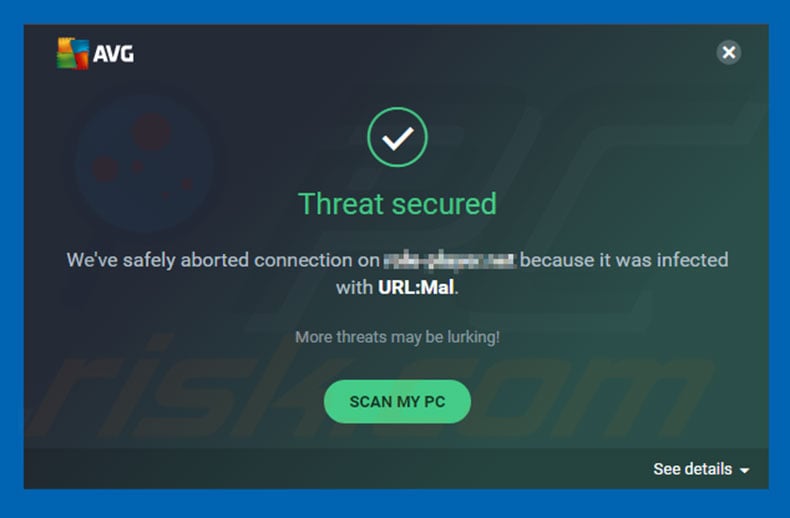
URL:MAL overview
As mentioned above, URL:MAL is the name of a potential threat. By delivering warnings of this threat, AVG and Avast anti-virus suites attempt to prevent users from visiting malicious sites. It is normal for users to encounter this warning occasionally, but frequent URL:MAL warnings indicate the presence of adware-type applications.
These deliver third party content on visited websites. To achieve this, adware-type apps employ various tools that inject visited websites with malicious scripts.
These trigger URL:MAL warnings. Bear in mind that, once clicked, third party content (most of which are intrusive advertisements) might redirect to infectious websites and run other scripts that download and install potentially unwanted applications or even malware. Therefore, clicking them can result in high-risk computer infections.
Another important issue is information tracking. Research shows that adware often gathers information relating to browsing activity. Collected data typically includes personal details that developers share with third parties (who generate revenue by misusing private information).
Therefore, data tracking can lead to serious privacy issues or even identity theft. If you continually encounter URL:MAL warnings, there is a high probability that your system is infected. Therefore, you should eliminate all dubious applications/browser plug-ins and scan the system with a reputable anti-virus/anti-spyware suites to check if there are any remnants.
| Name | URL:MAL malware |
| Threat Type | Adware, Unwanted ads, Pop-up Virus |
| Symptoms | Seeing advertisements not originating from the sites you are browsing. Intrusive pop-up ads. Decreased Internet browsing speed. |
| Distribution methods | Deceptive pop-up ads, free software installers (bundling), fake flash player installers. |
| Damage | Decreased computer performance, browser tracking - privacy issues, possible additional malware infections. |
| Malware Removal (Windows) |
To eliminate possible malware infections, scan your computer with legitimate antivirus software. Our security researchers recommend using Combo Cleaner. Download Combo CleanerTo use full-featured product, you have to purchase a license for Combo Cleaner. 7 days free trial available. Combo Cleaner is owned and operated by RCS LT, the parent company of PCRisk.com. |
Adware examples
There are hundreds of adware-type applications, all of which are virtually identical (for example, HidenGate, Amazon Shopping Assistant, ShutDownTime, Smart Application Controller, Instagram2go, etc.) All offer certain "useful features", however, the only purpose of all adware is to generate revenue for the developers, and thus most are useless.
Rather than enabling the functionality promised, potentially unwanted applications pose a direct threat to your privacy and browsing safety.
How did adware install on my computer?
In some cases, adware-type apps have official download websites, however, most infiltrate systems without permission, since developers proliferate them using intrusive advertising and "bundling" methods (stealth installation of third party program together with regular apps).
Developers know that users often rush download/installation processes and skip steps. Therefore, all "bundled" apps are hidden within "Custom/Advanced" settings (or other sections) of the download/installation processes.
Furthermore, many users often click various advertisements and skip download/installation steps. This behavior often leads to inadvertent installation of rogue applications.
How to avoid installation of potentially unwanted applications?
Lack of knowledge and careless behavior are the main reasons for computer infections. The key to safety is caution. Therefore, pay close attention when downloading/installing software and browsing the Internet in general. Carefully analyze each download/installation step and opt-out of all additionally-included programs.
Third party downloaders/installers should also never be used, since developers monetize them by promoting ("bundling") rogue apps. Download software from official sources only, using direct download links.
Intrusive advertisements typically seem legitimate, as developers invest many resources into their design, however, they often redirect to dubious sites (gambling, adult dating, pornography, etc.). If you continually encounter these ads, eliminate all dubious applications/browser add-ons immediately.
If your computer is already infected with rogue applications, we recommend running a scan with Combo Cleaner Antivirus for Windows to automatically eliminate them.
Deceptive free software installer proliferating adware-type applications:
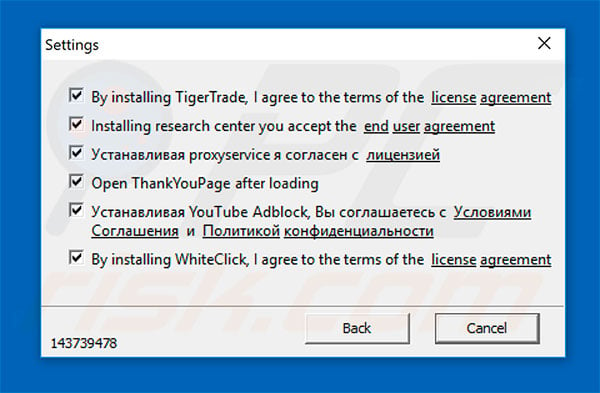
Instant automatic malware removal:
Manual threat removal might be a lengthy and complicated process that requires advanced IT skills. Combo Cleaner is a professional automatic malware removal tool that is recommended to get rid of malware. Download it by clicking the button below:
DOWNLOAD Combo CleanerBy downloading any software listed on this website you agree to our Privacy Policy and Terms of Use. To use full-featured product, you have to purchase a license for Combo Cleaner. 7 days free trial available. Combo Cleaner is owned and operated by RCS LT, the parent company of PCRisk.com.
Quick menu:
- What is URL:MAL?
- STEP 1. Uninstall adware applications using Control Panel.
- STEP 2. Remove adware from Internet Explorer.
- STEP 3. Remove rogue plug-ins from Google Chrome.
- STEP 4. Remove adware-type extensions from Mozilla Firefox.
- STEP 5. Remove malicious extensions from Safari.
- STEP 6. Remove rogue plug-ins from Microsoft Edge.
Adware removal:
Windows 11 users:

Right-click on the Start icon, select Apps and Features. In the opened window search for the application you want to uninstall, after locating it, click on the three vertical dots and select Uninstall.
Windows 10 users:

Right-click in the lower left corner of the screen, in the Quick Access Menu select Control Panel. In the opened window choose Programs and Features.
Windows 7 users:

Click Start (Windows Logo at the bottom left corner of your desktop), choose Control Panel. Locate Programs and click Uninstall a program.
macOS (OSX) users:

Click Finder, in the opened screen select Applications. Drag the app from the Applications folder to the Trash (located in your Dock), then right click the Trash icon and select Empty Trash.
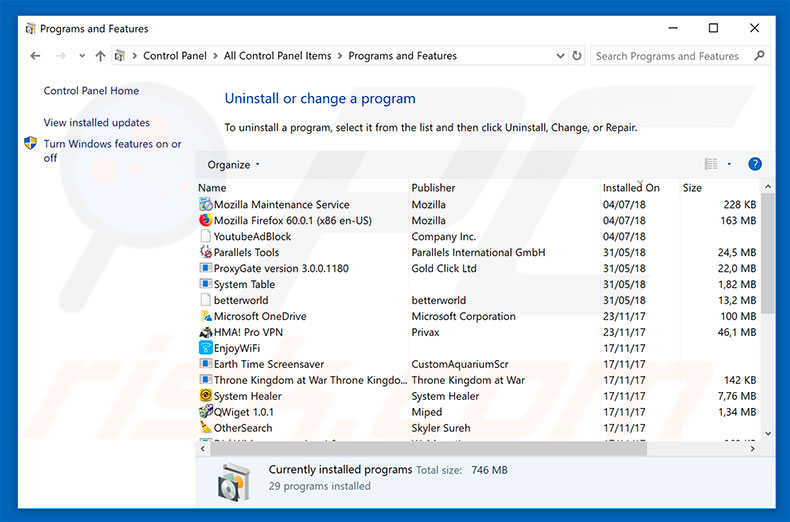
In the uninstall programs window, look for any potentially unwanted applications, select these entries and click "Uninstall" or "Remove".
After uninstalling the potentially unwanted application that causes URL:MAL redirects, scan your computer for any remaining unwanted components or possible malware infections. To scan your computer, use recommended malware removal software.
DOWNLOAD remover for malware infections
Combo Cleaner checks if your computer is infected with malware. To use full-featured product, you have to purchase a license for Combo Cleaner. 7 days free trial available. Combo Cleaner is owned and operated by RCS LT, the parent company of PCRisk.com.
Remove adware from Internet browsers:
Video showing how to remove potentially unwanted browser add-ons:
 Remove malicious add-ons from Internet Explorer:
Remove malicious add-ons from Internet Explorer:
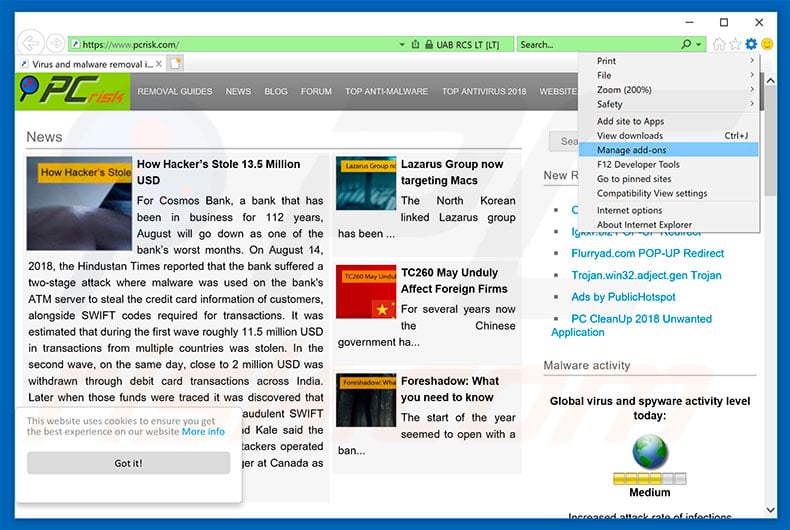
Click the "gear" icon ![]() (at the top right corner of Internet Explorer), select "Manage Add-ons". Look for any recently-installed suspicious browser extensions, select these entries and click "Remove".
(at the top right corner of Internet Explorer), select "Manage Add-ons". Look for any recently-installed suspicious browser extensions, select these entries and click "Remove".
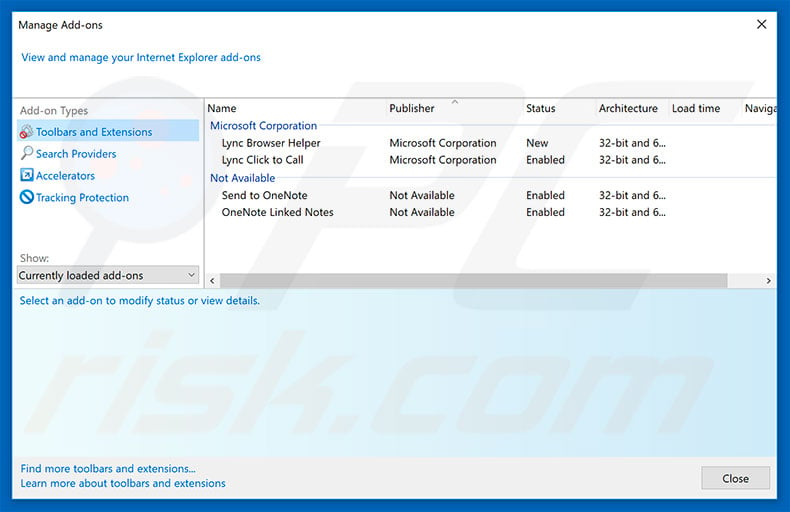
Optional method:
If you continue to have problems with removal of the url:mal malware, reset your Internet Explorer settings to default.
Windows XP users: Click Start, click Run, in the opened window type inetcpl.cpl In the opened window click the Advanced tab, then click Reset.

Windows Vista and Windows 7 users: Click the Windows logo, in the start search box type inetcpl.cpl and click enter. In the opened window click the Advanced tab, then click Reset.

Windows 8 users: Open Internet Explorer and click the gear icon. Select Internet Options.

In the opened window, select the Advanced tab.

Click the Reset button.

Confirm that you wish to reset Internet Explorer settings to default by clicking the Reset button.

 Remove malicious extensions from Google Chrome:
Remove malicious extensions from Google Chrome:
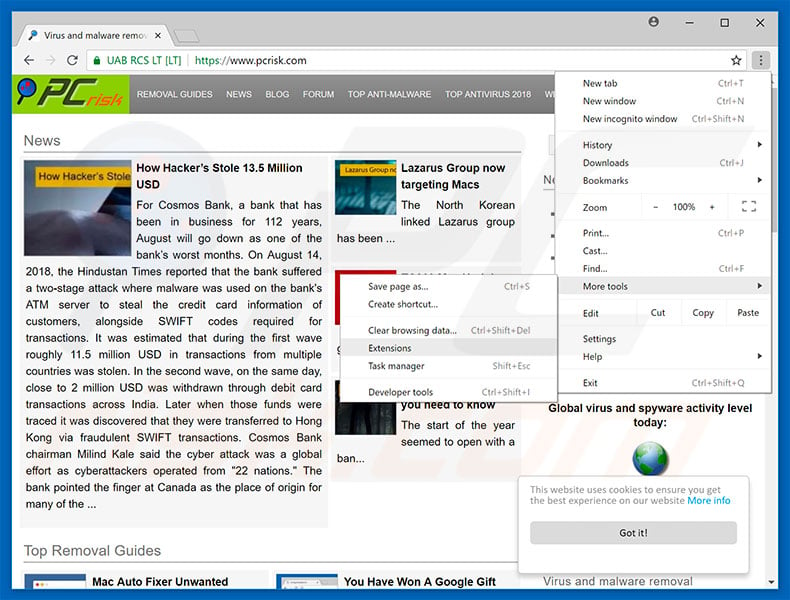
Click the Chrome menu icon ![]() (at the top right corner of Google Chrome), select "More tools" and click "Extensions". Locate all recently-installed suspicious browser add-ons and remove them.
(at the top right corner of Google Chrome), select "More tools" and click "Extensions". Locate all recently-installed suspicious browser add-ons and remove them.
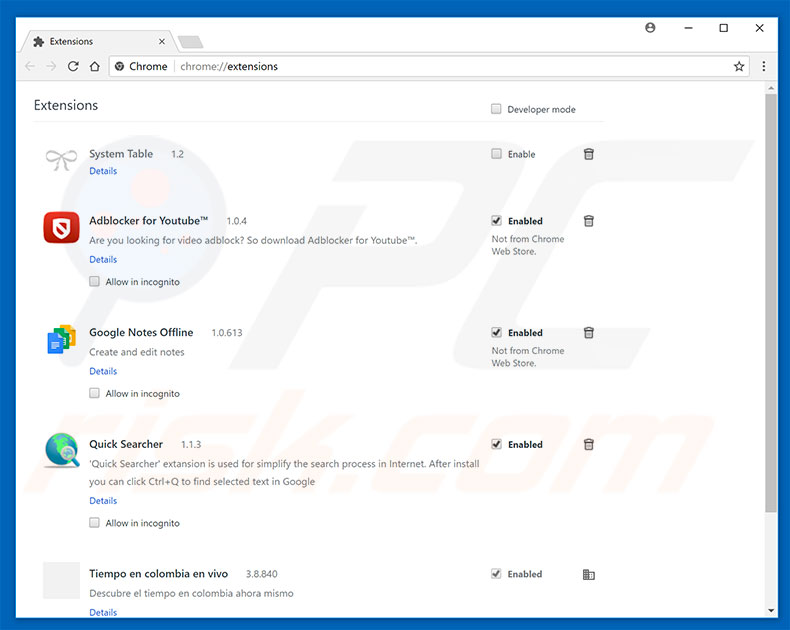
Optional method:
If you continue to have problems with removal of the url:mal malware, reset your Google Chrome browser settings. Click the Chrome menu icon ![]() (at the top right corner of Google Chrome) and select Settings. Scroll down to the bottom of the screen. Click the Advanced… link.
(at the top right corner of Google Chrome) and select Settings. Scroll down to the bottom of the screen. Click the Advanced… link.

After scrolling to the bottom of the screen, click the Reset (Restore settings to their original defaults) button.

In the opened window, confirm that you wish to reset Google Chrome settings to default by clicking the Reset button.

 Remove malicious plug-ins from Mozilla Firefox:
Remove malicious plug-ins from Mozilla Firefox:
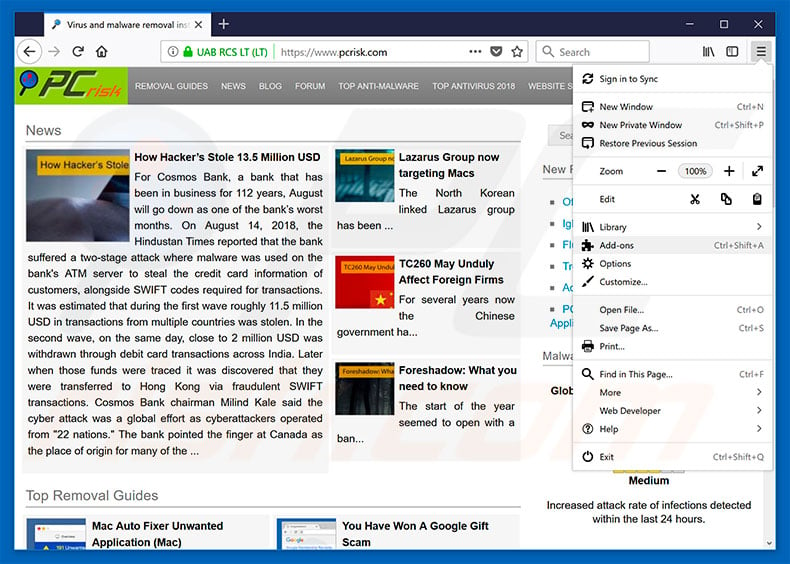
Click the Firefox menu ![]() (at the top right corner of the main window), select "Add-ons". Click "Extensions", in the opened window, remove all recently-installed suspicious browser plug-ins.
(at the top right corner of the main window), select "Add-ons". Click "Extensions", in the opened window, remove all recently-installed suspicious browser plug-ins.
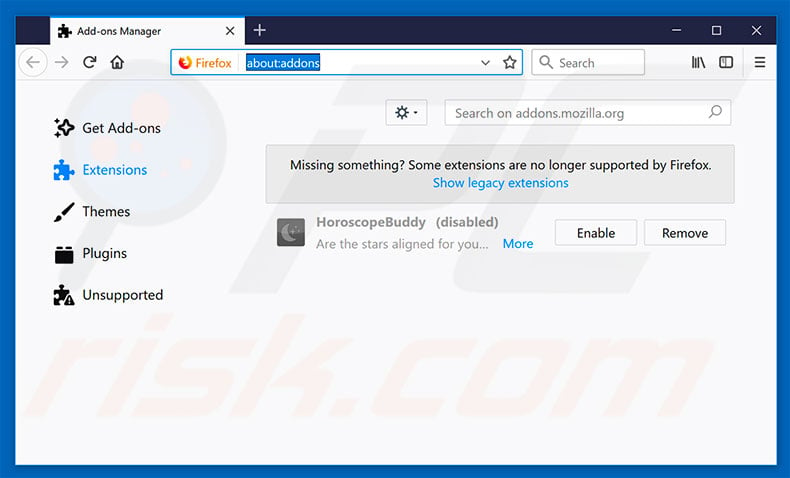
Optional method:
Computer users who have problems with url:mal malware removal can reset their Mozilla Firefox settings.
Open Mozilla Firefox, at the top right corner of the main window, click the Firefox menu, ![]() in the opened menu, click Help.
in the opened menu, click Help.

Select Troubleshooting Information.

In the opened window, click the Refresh Firefox button.

In the opened window, confirm that you wish to reset Mozilla Firefox settings to default by clicking the Refresh Firefox button.

 Remove malicious extensions from Safari:
Remove malicious extensions from Safari:

Make sure your Safari browser is active, click Safari menu, and select Preferences....

In the opened window click Extensions, locate any recently installed suspicious extension, select it and click Uninstall.
Optional method:
Make sure your Safari browser is active and click on Safari menu. From the drop down menu select Clear History and Website Data...

In the opened window select all history and click the Clear History button.

 Remove malicious extensions from Microsoft Edge:
Remove malicious extensions from Microsoft Edge:

Click the Edge menu icon ![]() (at the upper-right corner of Microsoft Edge), select "Extensions". Locate all recently-installed suspicious browser add-ons and click "Remove" below their names.
(at the upper-right corner of Microsoft Edge), select "Extensions". Locate all recently-installed suspicious browser add-ons and click "Remove" below their names.

Optional method:
If you continue to have problems with removal of the url:mal malware, reset your Microsoft Edge browser settings. Click the Edge menu icon ![]() (at the top right corner of Microsoft Edge) and select Settings.
(at the top right corner of Microsoft Edge) and select Settings.

In the opened settings menu select Reset settings.

Select Restore settings to their default values. In the opened window, confirm that you wish to reset Microsoft Edge settings to default by clicking the Reset button.

- If this did not help, follow these alternative instructions explaining how to reset the Microsoft Edge browser.
Summary:
 Commonly, adware or potentially unwanted applications infiltrate Internet browsers through free software downloads. Note that the safest source for downloading free software is via developers' websites only. To avoid installation of adware, be very attentive when downloading and installing free software. When installing previously-downloaded free programs, choose the custom or advanced installation options – this step will reveal any potentially unwanted applications listed for installation together with your chosen free program.
Commonly, adware or potentially unwanted applications infiltrate Internet browsers through free software downloads. Note that the safest source for downloading free software is via developers' websites only. To avoid installation of adware, be very attentive when downloading and installing free software. When installing previously-downloaded free programs, choose the custom or advanced installation options – this step will reveal any potentially unwanted applications listed for installation together with your chosen free program.
Post a comment:
If you have additional information on url:mal malware or it's removal please share your knowledge in the comments section below.
Frequently Asked Questions (FAQ)
What is "URL:MAL"?
URL:MAL - is a detection name used by certain anti-virus software (e.g., AVG, Avast, etc.) to warn users when they are about to enter a malicious website. Frequent occurrences of these warnings are a sign of a potential adware infection, as this rogue software is known to promote dangerous sites.
What harm can adware cause?
Adware delivers ads that not only diminish the browsing experience but also promote deceptive/malicious content capable of causing serious problems (e.g., system infections, financial losses, etc.). Furthermore, advertising-supported software is considered to be a threat to user privacy, as it typically has data tracking functionalities.
What does adware do?
Adware stands for advertising-supported software. Its primary functions can include enabling the placement of ads on visited sites and/or other interfaces, force-opening webpages, and collecting private data.
How do adware developers generate revenue?
Adware developers profit mainly through affiliate programs by endorsing various websites, apps, products, services, and other content.
Will Combo Cleaner protect me from malicious websites and remove adware?
Yes, Combo Cleaner is designed to detect and eliminate threats. Should you enter a rogue, deceptive, or malicious website - you will be warned immediately, and further access to the page will be blocked. Combo Cleaner can remove not only adware-type apps but all manner of browser hijackers, unwanted applications, and even most of the known malware infections.
It is noteworthy that manual removal (unaided by security programs) might not be ideal. In some instances, even after the undesirable software (e.g., adware) has been manually removed - various file leftovers remain within the system. Furthermore, the remaining components may continue to run and cause problems. Therefore thoroughness is essential in software removal.
Share:

Tomas Meskauskas
Expert security researcher, professional malware analyst
I am passionate about computer security and technology. I have an experience of over 10 years working in various companies related to computer technical issue solving and Internet security. I have been working as an author and editor for pcrisk.com since 2010. Follow me on Twitter and LinkedIn to stay informed about the latest online security threats.
PCrisk security portal is brought by a company RCS LT.
Joined forces of security researchers help educate computer users about the latest online security threats. More information about the company RCS LT.
Our malware removal guides are free. However, if you want to support us you can send us a donation.
DonatePCrisk security portal is brought by a company RCS LT.
Joined forces of security researchers help educate computer users about the latest online security threats. More information about the company RCS LT.
Our malware removal guides are free. However, if you want to support us you can send us a donation.
Donate
▼ Show Discussion